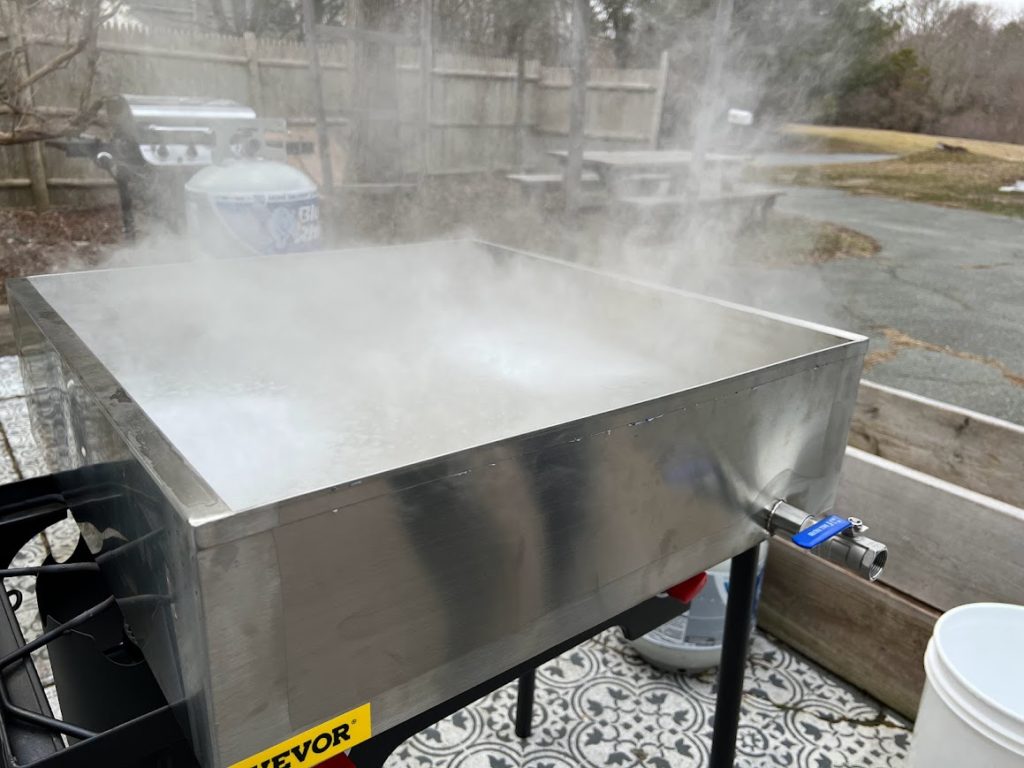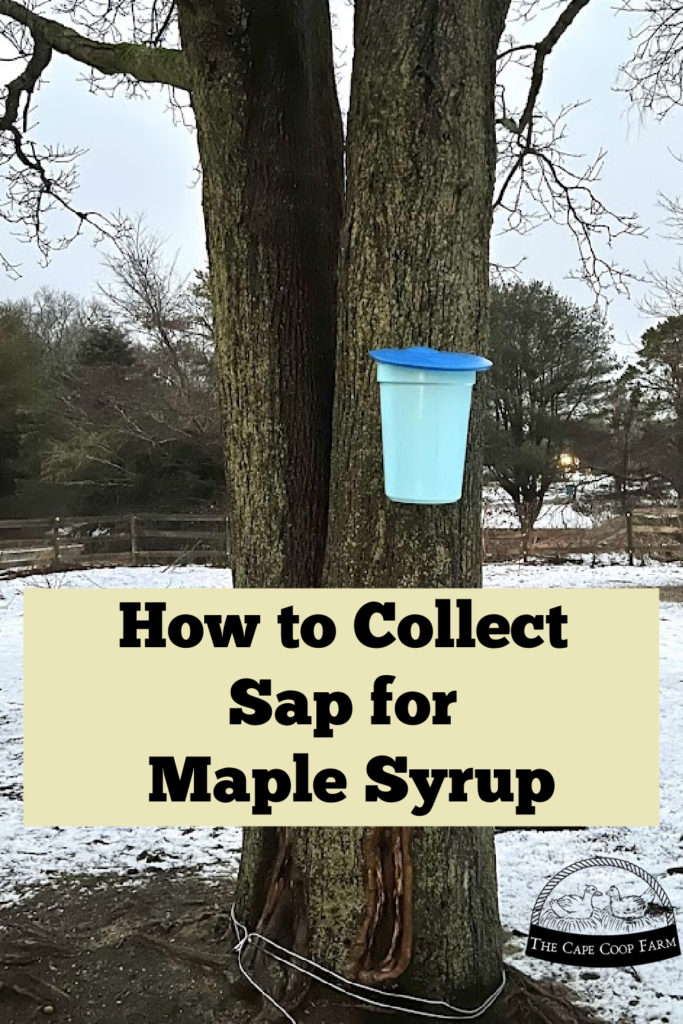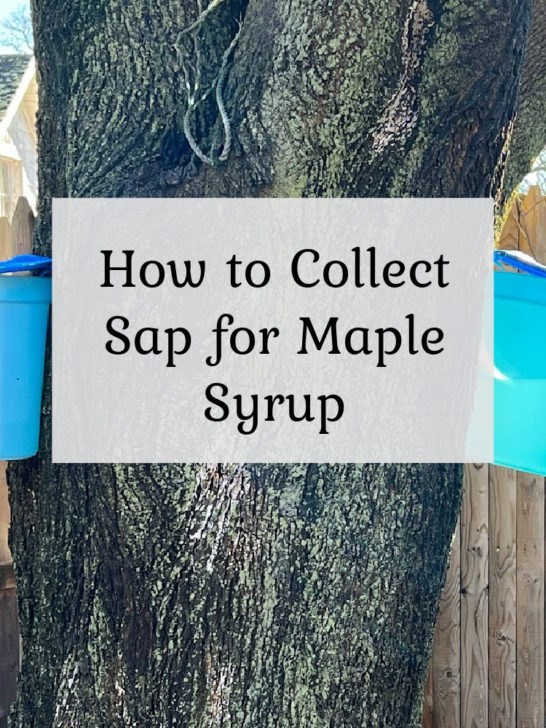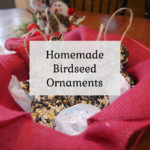---------------------------------------------------------
When we were looking at our house for the first time, one of the things that I loved was all the mature maples in the yard. Not only were they pretty but my first thought was “we can make our own maple syrup!” As a lifelong New Englander, I have always wanted to try my hand at tapping trees and making my own maple syrup. But where to start with collecting sap for maple syrup?
This will be a two part series, in this the first part we will discuss how to tap trees and collect sap. Click here to jump to part two where we will discuss turning sap into syrup.
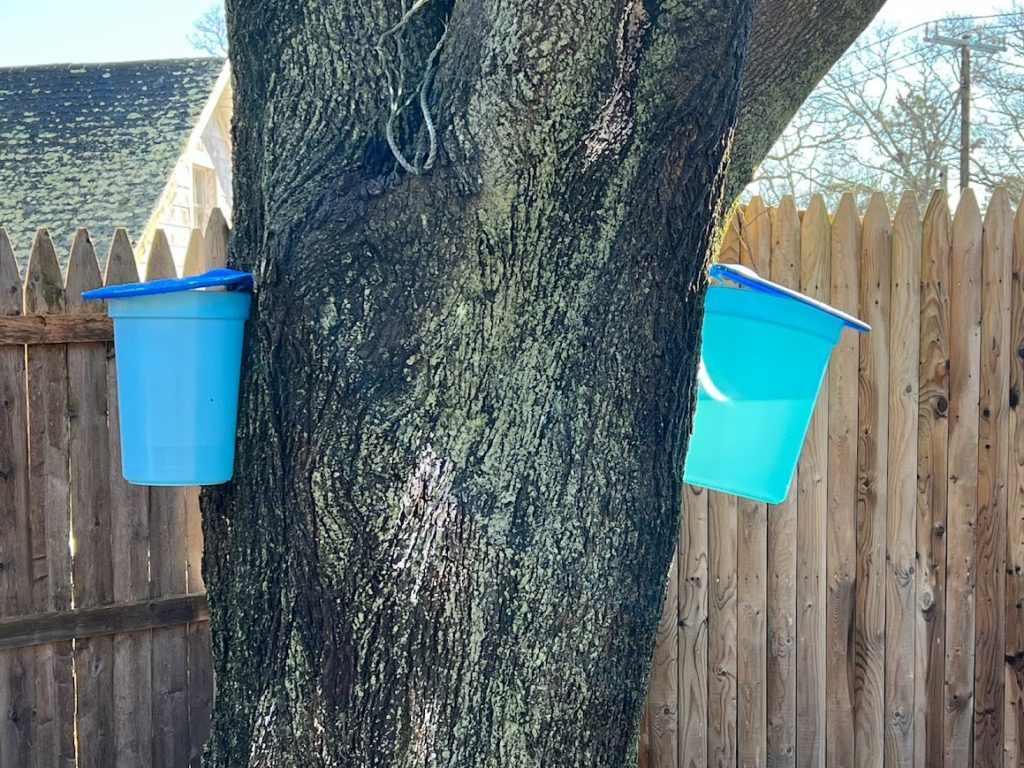
Identify your trees
First and foremost, you need maple trees to tap. So the first place to start is in identifying the trees. It was the middle of winter when we moved in. I am not an arborist, I could tell by the trunk they were maples, but I couldn’t tell which kind. Spring rolled around, I used my plant ID app and was super disappointed to find out they were Norway Maples. I didn’t know much but I was pretty sure you needed Sugar Maples to make maple syrup. Thankfully I was wrong!
Yes, Sugar Maples are the rock stars of the syrup world. They produce the most amount of sap, have the longest collection season, and their sap has the highest sugar concentration. But they are not the only maple trees that you can tap for syrup making. Below are some other commonly tapped maple varieties.
Beyond the Sugar Maple
Black Maple
Black Maple is the second-best choice if you don’t have Sugar Maples. The sap is nearly as sweet and the sap season is almost as long as Sugar Maples. The only real issue with Black Maples is that they are not as common. In the US, Black Maples are most concentrated around the Great Lakes regions.
Red & Silver Maples
Other good sap contenders are Red and Silver Maples. The sugar content in both Red and Silver is lower than Black, but not by much. Red and Silver Maples are not generally used in production farms because their sap season is shorter than other maples. They tend to produce buds early in the spring. Once a tree’s buds pop out in the spring, sap collection should stop. Silver maples produce more “sugar sand” than other varieties. Sugar sand is excess minerals that need to be filtered out during syrup production.
Norway Maples
The advantage Norway Maples have over other maples is that they are adaptable. They are common and will thrive in many different climates and conditions (so much so it can be considered invasive). The reason they are not used commercially is that the sugar content is lower. This means you need to collect more sap to produce syrup. Once that sap is boiled down, however, the resulting syrup tastes the same as Sugar Maple syrup. Typically you will need to collect 40 gallons of Sugar Maple sap for 1 gallon of syrup. Norway Maples might need 50-60 gallons of sap for 1 gallon of syrup (depending on weather and growing conditions).
Boxelder Maples
Boxelders are smaller scrub maple trees so won’t produce as much as large Sugar maples. The sugar content is also fairly low. You will need 60-70 gallons of sap for 1 gallon of syrup. They aren’t the ideal choice, but you certainly can make syrup with them!
Is it worth it? How much syrup can I get from just a few trees?
I personally think it’s worth it, especially if already have a lot of the equipment or can find it second hand. If you have just a few trees you aren’t going to be making enough to sell but you certainly could make enough for your family’s use for the year. We have over a dozen Norway Maples in our yard, in our first year, we had just three taps in our two largest trees. We got a late start and missed more than half the season. In the last three weeks of the season, we managed to collect 27 gallons of sap which boiled down to 75 oz of syrup (9 eight-ounce bottles). Plenty for pancakes and cooking!
How big should a tree be to tap it?
Trees should be at least 10 inches in diameter and over 5 feet tall to handle one tap. If the tree is between 15-20 inches in diameter you can put two taps in. Trees over 25 inches can handle three taps. You should not install more than 3 taps in a tree no matter its size for the tree’s health. Trees should be healthy and free from any type of disease. A tree in direct sunlight will have better sap flow.
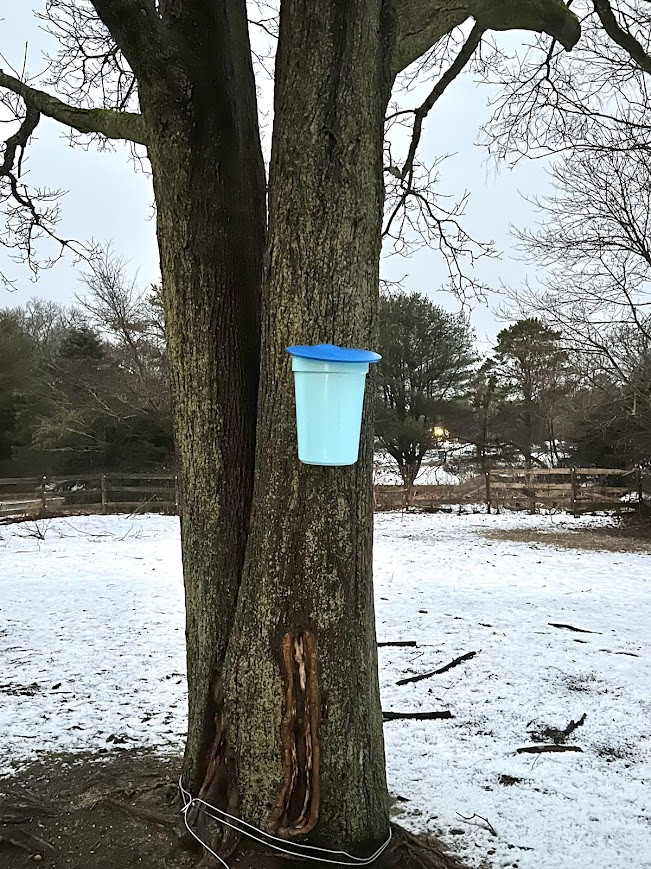
When should you tap your trees?
Tapping your trees at the right time is one of the most important factors in a good sap collection season. Tap too early and the tap hole will heal over and clog up your spile. Tap too late and you’ll miss out on sap season.
Sap flows best when there are alternating freeze and thaw weather patterns. This creates the pressure needed inside the tree to make the sap flow. Nighttime temps below 30 degrees and daytime temps above 40 degrees are the ideal sap collecting conditions. Depending on your region this will likely be sometime in February – March. This is why syrup making is more successful in the northern parts of the US. In the south, you often don’t get the right weather conditions. Collection season runs until the trees put out buds, which will be around late March-mid April depending on weather and the type of maple you have. At that time, the spiles should be removed from the trees so the tree can heal over the hole.
There’s an app for that
Of course there is. I use SapTapApp (not a paid endorsement, I just love them!). It pulls local weather conditions for you and will give you a tapping “Flowcast” for the next 10 days. The app will rate each day on a 1-5 scale, 1 for empty sap buckets to 5 for overflowing buckets. This is helpful information for deciding when to tap but also during the season to see which days you’ll need to empty your buckets more often. They also have a handy log section where you can record information on when you tapped and how much was collected daily.
Assemble your tapping equipment
To tap your trees you will need some equipment:
- Drill bit, 5/16 or 7/16 inch are the most common sizes, the size you need depends on the size of your spile
- Hammer
- Tapping Spile (it is helpful if they have a hook attached to hang your bucket)
- Food grade collection bucket or jug (should have a lid to keep out rain & debris)
- Food Grade larger buckets for holding unprocessed sap
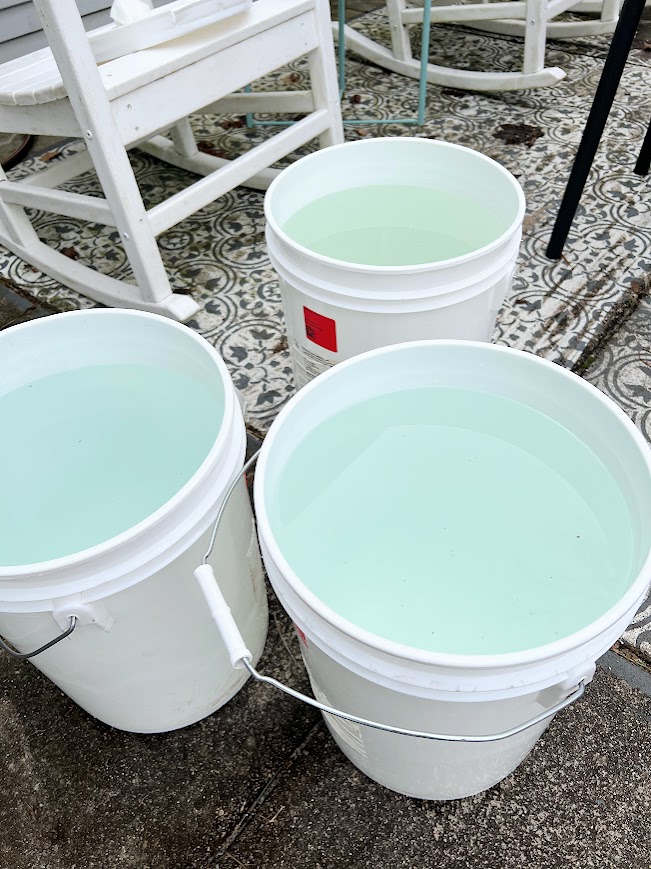
How to tap your tree
Clean & sanitize your spile and buckets.
Mark 1.5 inches from the tip of your drill bit by wrapping tape around it. Find the spot on your tree, it should be 2-4 feet from the ground. Avoid areas of darkness or decay. The south side of the tree is generally considered best, the warm sun can encourage sap flow. If possible, drill above a large root or under a large branch. In subsequent years, don’t retap the same hole, and don’t tap within 6 inches horizontally from old tap holes.
Drill 1.5 inches into the tree (use the mark on your drill bit as your guide) at a slight upward angle. Reverse the drill direction to keep the drill bit moving as you pull it out for a clean hole. If you keep the drill bit in motion it should pull all the wood chips out with it. Do not blow into the hole after drilling. Don’t wiggle the drill inside the hole. If you make the hole too large, your spile will fall out. Just straight in, straight out!
Gently tap the spile into the hole. If you tap too hard, it could cause the wood around the hole to split which could make your spile fall out. Hang your bucket and you are ready to start collecting! Buckets should have a lid to keep out rain and debris. Sap will be clear & thin, it looks like water.
Storing collected maple sap
You should empty your collection buckets into a larger container every day and store it in a cool place until you are ready to process it. I pour my sap into clean, food grade 5 gallon buckets with lids. Sap is a perishable product. To avoid bacteria growth, you should store sap at under 38 degrees and use or freeze within 7 days. If you have snow on the ground you can bury the buckets in the snow. If you have a spare refrigerator you can store sap there. Early in the season when the temps are cold, I store my unprocessed sap in my unheated barn. Towards the end of the sap season when outdoor temps are rising I put the buckets in a large stock tank with bags of ice in my barn. You can also freeze the sap until you are ready to process.
Boiling down sap into a finished syrup can take 12 hours or more depending on your setup. For most hobbyists who are only tapping a handful of trees this isn’t something you have time to do every day. If you work and only have time to boil on the weekends, what should you do if you don’t have refrigerator space for a week’s worth of sap? You can do small boils every 1-3 days just to reduce the volume of sap, then freeze the condensed sap. Let’s say you have collected 5 gallons of sap. This is going to boil down to just 14 oz of syrup but will take many hours. Boiling that 5 gallons down to just 1-2 gallons will not take nearly as long. You can then put the condensed sap in a few larger freezer bags for later.
Part Two – Turning Sap into Syrup
Now that you have all that sap, it’s time to turn it into syrup. Click here to read part 2 of this series where we will turn sap into syrup!
